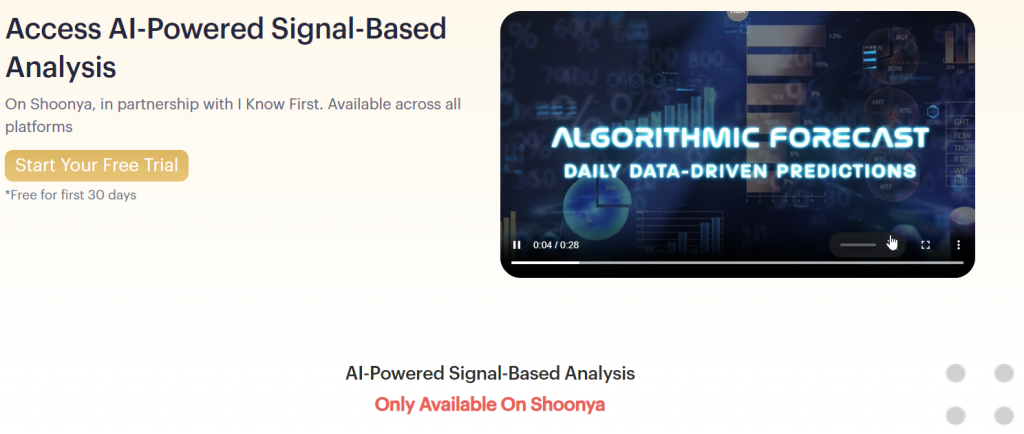20 Excellent Ways For Deciding On Ai Trading Bots
20 Excellent Ways For Deciding On Ai Trading Bots
Blog Article
Top 10 Tips For Selecting The Right Ai Platform To Trade Ai Stocks, From Penny To copyright
Choosing the right AI platform for stock trading, whether penny stocks or copyright, is crucial for success. Here are 10 crucial tips to help guide your choice.
1. Set your trading goals
Tips: Determine your primary focus --penny stocks, copyright, or both--and define whether you're looking for long-term investments, short-term trades, or algo-based automation.
The reason: Different platforms are great at certain things and having a clear understanding of your goals will enable you to pick the one that best suits your needs.
2. Analyze the accuracy of predictive models
Verify the platform's accuracy in the prediction of.
How can you determine the reliability of a product? Look up backtests published and user feedback.
3. Real-Time Data Integration
Tip - Make sure that the platform provides live feeds of market data, particularly for fast-moving asset classes like penny stocks and copyright.
Delayd data can cause miss opportunities as well as poor trade execution.
4. Examine the customizability
Select platforms that have custom parameters as well as indicators and strategies that fit your trading style.
For example, platforms like QuantConnect and Alpaca provide a range of options for customization to techno-savvy users.
5. The focus is on automation features
Tips: Select AI platforms with powerful automation abilities, including stop loss, take profit and trailing-stop capabilities.
What is the reason? Automation cuts down trading time, as well as assisting traders complete their trades with precision.
6. Use tools to evaluate sentiment analysis
TIP: Pick platforms that provide AI-driven sentiment analysis, particularly for penny stocks and copyright that are influenced by news and social media.
The reason: Market mood could be an important driver of fluctuations in prices that are short-term.
7. Prioritize the Easy of Use
Make sure the platform is user-friendly and comes with clearly written instructions.
A long learning curve could create a challenge to trade efficiently.
8. Check for regulatory compliance
Tip: See if the platform adheres to the regulations for trading in your region.
copyright Check for features that support KYC/AML.
For penny stocks, make sure you follow the guidelines of the SEC.
9. Cost Structure:
Tip: Understand the platform's pricing--subscription fees, commissions, or hidden costs.
The reason: A platform that has cost-intensive fees could reduce profits for trades that aren't very large, especially in copyright or penny stocks.
10. Test via Demo Accounts
Check out the platform by using the demo account.
What is the reason: A test run will reveal whether the platform is up to your standards in terms of performance and function.
Bonus: Make sure to check the Community and Customer Support
Tip: Select platforms that have active communities and strong support.
The reason: The advice of peers and solid support can help solve problems and improve your strategy.
By carefully evaluating platforms based on these parameters and criteria, you can discover the one that is most closely with your style of trading regardless of whether you're trading penny stocks, copyright or both. Have a look at the top trade ai for site recommendations including free ai trading bot, best ai stock trading bot free, ai stock analysis, ai predictor, trading bots for stocks, ai stocks, coincheckup, ai for trading stocks, ai penny stocks to buy, ai stock and more. 
Top 10 Tips To Pay Close Attention To Risk Metrics In Ai Stocks And Stock Pickers As Well As Predictions
Risk metrics are crucial to ensure that your AI stock picker and predictions are sane and resistant to market fluctuations. Knowing and managing risk can assist in protecting your investment portfolio and enable you to make informed, informed decisions. Here are 10 suggestions to incorporate risk indicators into AI investing and stock selection strategies.
1. Know the most important risk metrics Sharpe ratio, maximum drawdown and the volatility
Tips Focus on the most important risk indicators, like the maximum drawdown as well as volatility, to assess the AI model's risk-adjusted results.
Why:
Sharpe ratio is a measure of the return on investment relative to the risk level. A higher Sharpe ratio indicates better risk-adjusted performance.
It is possible to use the maximum drawdown to calculate the largest loss between peak and trough. This will allow you to comprehend the potential for large losses.
Volatility quantifies price fluctuations as well as market risk. Low volatility indicates stability, whereas the higher volatility indicates greater risk.
2. Implement Risk-Adjusted Return Metrics
Tips: Make use of risk-adjusted return indicators such as the Sortino ratio (which concentrates on risk of downside) and Calmar ratio (which measures returns to the maximum drawdowns) to evaluate the true performance of your AI stock picker.
What are the reasons: The metrics will show you how your AI model performs in relation to its level of risk. This will let you determine whether or not the risk is justifiable.
3. Monitor Portfolio Diversification to Reduce Concentration Risk
Tip - Use AI technology to improve your diversification, and make sure that your portfolio is well-diversified across different asset classes and geographical regions.
Why diversification is beneficial: It reduces the risk of concentration. This occurs when portfolios are heavily dependent on a particular stock, market, or sector. AI can help identify connections between assets and then adjust the allocation to lessen the risk.
4. Follow beta to measure market sensitivity
Tip: You can use the beta coefficient to gauge the sensitivity of your portfolio to market movement of your stock or portfolio.
Why: A portfolio with more than 1 beta is more volatile than the market, while having a beta lower than 1 indicates lower volatility. Understanding beta can help tailor the risk exposure to market fluctuations and also the tolerance of investors.
5. Install Stop Loss, and Set Profit Levels that are based on Risk Tolerance
Set your stop loss and take-profit level using AI predictions and risk models to manage the risk of losing money.
The reason for this is that stop loss levels are there to protect against excessive losses. Take profit levels are there to ensure gains. AI will determine the most the most optimal levels of trading based on historical volatility and price action and maintain the balance between risk and reward.
6. Monte Carlo Simulations Risk Scenarios
Tip : Monte Carlo models can be run to determine the potential results of portfolios in various risk and market conditions.
Why: Monte Carlo simulates can provide you with a probabilistic view on the performance of your investment portfolio for the foreseeable future. They allow you to plan better for different scenarios of risk (e.g. huge losses and high volatility).
7. Evaluation of Correlation for Assessing Risques that are Systematic or Unsystematic
Tips. Utilize AI to analyze the correlations between your portfolio of assets and market indexes. You can identify both systematic risks as well as non-systematic ones.
Why: Systematic risk affects all markets (e.g. economic downturns), while the risk of unsystematic is specific to specific assets (e.g. specific issues for companies). AI can reduce unsystematic and other risks by recommending less-correlated assets.
8. Monitoring Value at Risk (VaR) to quantify the potential loss
Tip - Utilize Value at Risk (VaR) models, built on confidence levels to calculate the potential loss in a portfolio over the timeframe.
Why? VaR lets you know what your worst-case scenario would be in terms of losses. It provides you with the chance to evaluate the risk of your portfolio under normal market conditions. AI will adjust VaR according to change market conditions.
9. Create dynamic risk limits that are based on current market conditions
Tips. Use AI to modify your risk limits dynamically depending on market volatility and economic conditions.
Why dynamic risk limits are a way to ensure your portfolio is not exposed to excessive risk during periods that are characterized by high volatility or uncertainty. AI can analyze the data in real time and adjust your portfolios to keep an acceptable risk tolerance. acceptable.
10. Make use of machine learning to predict risk factors as well as tail events
Tips: Make use of machine learning algorithms that are based on sentiment analysis and data from the past to identify the most extreme risk or tail-risks (e.g. market crashes).
The reason: AI models are able to identify risk patterns that other models may overlook. This helps identify and prepare for extremely rare market events. The analysis of tail-risks assists investors understand the possibility of catastrophic losses and plan for it in advance.
Bonus: Regularly reevaluate Risk Metrics in the context of evolving market conditions
Tips. Review and update your risk metrics as market conditions change. This will allow you to stay on top of the changing geopolitical and economic developments.
Why: Market conditions shift frequently, and relying on outdated risk models can result in inaccurate risk assessment. Regular updates enable the AI models to adapt to changing market dynamics and incorporate new risk factors.
Conclusion
By monitoring the risk indicators carefully and incorporating the data in your AI investment strategy, stock picker and prediction models you can build an adaptive portfolio. AI is a powerful tool which can be utilized to assess and manage the risk. Investors can make informed data-driven choices and balance potential returns with acceptable risks. These tips can help you build a solid risk management framework to improve the stability and efficiency of your investment. View the top rated use this link on ai stock trading for more tips including ai trading, ai trading software, ai for investing, ai stock trading app, ai trading, ai stock price prediction, copyright ai trading, ai trading app, ai stock market, coincheckup and more.